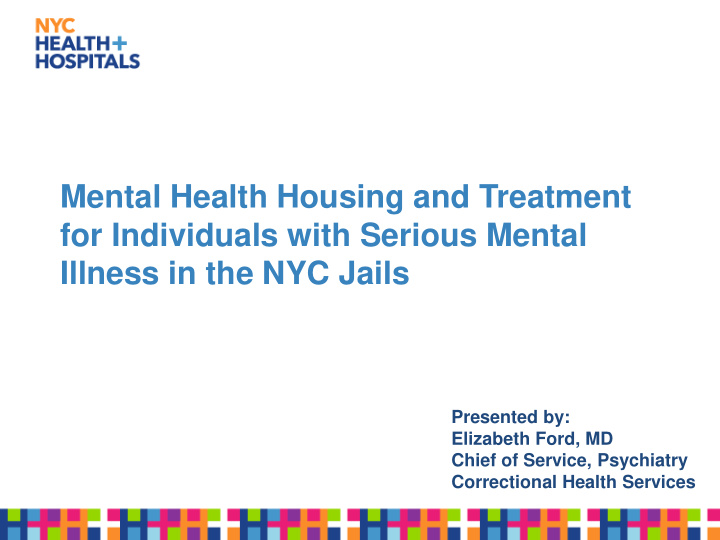



Mental Health Housing and Treatment for Individuals with Serious Mental Illness in the NYC Jails Presented by: Elizabeth Ford, MD Chief of Service, Psychiatry Correctional Health Services
Mental Health Service Population Data ~3700 “M” patients (~43% of jail) ~1100 SMI* patients (~31% of MH service; ~16% of jail) Schizophrenia spectrum ~29% Bipolar spectrum ~17% Depressive ~19% Trauma-related ~25% ~75% of patients with SMI housed on MO/PACE/CAPS ~97% of MO/PACE/CAPS are SMI SMI excluded from restrictive housing 37% of intakes are referred to MH Routine referrals: 48% of female intakes and 24% of male intakes Stat referrals: 11% of female intakes and 10% of male intakes 2% of ~38,000 intakes report a history of OPWDD involvement *SMI defined as schizophrenia spectrum, bipolar spectrum, depressive disorders, PTSD
Entry into the Mental Health Service First 24 ° Medical Intake Other Referral Sources: DOC Mental Health Evaluation Patients/sick call 24 ° -72 ° (Licensed MHC or psychiatric 311 providers) Legal advocates Community providers 0-3 Comprehensive Treatment Plan and medication Re-entry/Discharge Plan management, if indicated weeks (Social Work staff) (Licensed MHC, psychologists, psychiatric providers) In addition to providing treatment for patients with mental health diagnoses, CHS also: Offers screening for PTSD, SUD, psychopathology and I/DD to all 18-21 year-olds • admitted to the jail who are not referred to MH upon medical intake Provides in-jail care coordination to high risk 18-21 year-olds charged with violent • felonies who are not in MH housing
Mental Health Levels of Care General Population (GP) 10 clinics Mental Health Units (MO) 17 units comprised of 540 beds CAPS/PACE Units 7 units comprised of 181 beds Hospital Forensic Inpatient Beds Bellevue Elmhurst 68 certified beds 14 certified beds Average length of stay: 3 weeks Average length of stay: 2 weeks
Mental Observation Units Since the CHS transition to Health + Hospitals: Implementation of supervisory structure for all staff Expanded group treatment, including creative art therapy and social work/re-entry groups Court liaisons Crisis Intervention Teams (CIT) Dedicated treatment teams Integration of social work and substance use into MH service Emphasis on continuity of care Continuous therapeutic relationship critically important Efforts underway in GP clinics where access is more challenging ~ 7% of mental health appointments are rescheduled by CHS
Treatment Teams Then and Now Then Psychiatrist/NP Therapist q 2 weeks q week Social work x 1 visit Now Social • Daily lists based on “what’s due” Worker Mental Art • Little to no continuity of care Health Therapist • Little inter-disciplinary communication Counselor Psychologist Substance (Team Use Leader) Counselor Psychiatrist Court Patient/Unit /NP Liaison • Treatment Teams • Continuity of Care • Community-Building
Therapeutic Housing Units for SMI Introduced by CHS in 2013, Clinical Alternative to Punitive Segregation (CAPS), serves patients diagnosed with SMI who have violated jail rules and otherwise would have been punished with solitary confinement Following the success of CAPS, CHS developed the Program for Accelerating Clinical Effectiveness (PACE), for SMI patients who have not infracted and have different behavioral health needs Since transitioning to Health + Hospitals, CHS requested and was approved to triple the number of PACE units to 12 by year 2020 Current units open: 6
Program for Accelerating Clinical Effectiveness (PACE) Bellevue Hospital Return Unit (Jan, 2015) Acute Care Unit (Feb, 2015) Intellectual/Developmental Disabilities (June, 2015) State Hospital (730) Return Unit (September, 2016) Women (March, 2017) Re-Entry focused in EMTC (February, 2018) Remaining six units are a priority
Characteristics of Therapeutic Housing Units for SMI 18-35 bed units with therapeutic design Light, open space Offices on units Private individual therapy spaces Most with private group space Modeled after Bellevue’s inpatient forensic psychiatry service All day treatment Multi-disciplinary clinical staff, including nursing Steady clinical and custody staff, team based training and care Rewards and incentives for good behavior and treatment adherence
Outcomes: PACE Units January 2016 - December 2018* Hospital Baseline Acute Care Re-Entry Outcome Step I/DD Unit 730 Unit (2014 CY Goal Unit Unit Metric Down (n=153) (n=155) MALE MO) (n=291) (n=210) (n=170) Medication 50% 30-63%** 90.5% 62.4% 83.1% 90.4% 86.0% Adherence increase 1.92/1000 1.44 Self-Harm person- (25% 0.55 1.05 2.93 0.35 1.62 Rate days reduction) 30-day re- 3.4/1000 2.55 hospitaliza person- (25% 1.29 0.70 0.00 0.40 0.14 tion rate days reduction) First year of Goal 3/17-12/18 FEMALE Data Tracking Outcome Metric (3/17-2/18) Medication Adherence 79.28% 15% increase 77.7% 3.29 Self-Harm Rate 4.39 (25% reduction) 3.45 30-day re- 0.85 hospitalization rate 1.14 (25% reduction) 1.05 *All rates per 1,000 person-days
Outcomes: Clinical Alternative to Punitive Segregation (CAPS) First year of Goal MALE Data Tracking Outcome Metric (CY 2018) Medication Adherence 70.81% 15% increase 3.91 Self-Harm Rate 5.23 (25% reduction) 30-day re- hospitalization 0.92 rate 1.22 (25% reduction) FEMALE First year of 3/17-12/18 Outcome Data Tracking Goal Metric (3/17-2/18) Medication Adherence 76.07% 15% increase 77.65% 1.72 Self-Harm (25% Rate 2.29 reduction) 2.79 30-day re- 0.34 hospitalizatio (25% n rate 0.46 reduction) 0.84 *All rates per 1,000 person-days
Improved Services for Individuals Found ICST In 2018, CHS voluntarily assumed management of the City’s Forensic Psychiatric Evaluation Court Clinics (FPECC) in the Bronx, Manhattan, Brooklyn, and Queens 121 individuals in jail awaiting a CPL 730 evaluation o 44% in MO/PACE/CAPS/Hospital Average number of days from order to report substantially reduced from 43 days to: 159 individuals s/p OMH restoration o 84% in MO/PACE/CAPS/Hospital Average wait time for transfer to OMH = 10 days PACE 730 Unit 730 Mobile Team
Are the Changes Working? No suicides in the mental health service in more than three years Limited need for medication over objection Self-harm rates have significantly dropped since January 2015 Since January 1 st , 2016, CHS hired a total of 89 psychologists, psychiatrists, and social workers
Recommend
More recommend